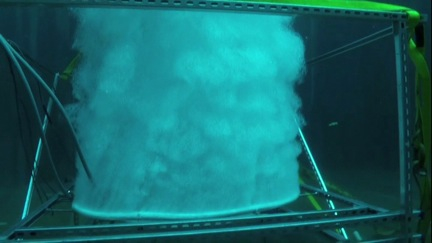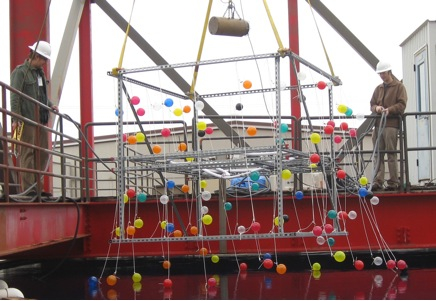
Kevin M. Lee -- klee@arlut.utexas.edu
Kevin T. Hinojosa -- kevinh@arlut.utexas.edu
Mark S. Wochner -- mwochner@arlut.utexas.edu
Applied Research Laboratories
The University of Texas at Austin
Austin, TX 78713
Theodore F. Argo IV -- targo@mail.utexas.edu
Preston S. Wilson -- pswilson@mail.utexas.edu
Mechanical Engineering Department
The University of Texas at Austin
Austin, TX 78713
Popular version of paper 2aUWb11
Presented Tuesday Morning, May 24, 2011
161st Meeting of the Acoustical Society of America, Seattle, Washington
Manmade, or anthropogenic, underwater noise is known to have the potential to disrupt marine life, including the possibility of affecting the migratory patterns of marine mammals. Noise created by pile driving and underwater construction, and noise radiated into the water by shipboard machinery can contain low frequencies, in the range of 10 Hz to 1000 Hz. To orient the reader with respect to these frequencies, human hearing operates between 20 Hz and 20,000 Hz. The lowest note on a piano is about 27 Hz, while middle C is about 260 Hz, and 1000 Hz corresponds to C two octaves above middle C. A traditional noise control approach is to erect a barrier around the noise source. To be effective in this low frequency range, such a barrier would have to be significantly larger that the noise source itself and more dense than the water, and hence is impractical in many cases. Research is underway at the University of Texas at Austin to develop practical and relatively inexpensive methods to significantly reduce the level of low-frequency sound emitted by underwater noise sources using either freely rising air bubbles, or tethered encapsulated air bubbles.
The key idea behind this approach is that an air bubble in water behaves like a mass on a spring, and hence it vibrates in response to an excitation. In this case, the acoustic noise excites the bubble into a volumetric oscillation, whereby the radius of the bubble oscillates about its equilibrium size in response to the passing acoustic wave. The air inside the bubble acts as a spring and a small layer of water around the bubble acts as a mass. Like a mass on a spring, an air bubble in water has a natural frequency of oscillation. It is inversely proportional to the bubble size and proportional to the bubble depth. For air bubbles in water near the ocean surface bubbles 1 mm in radius oscillate at about 3000 Hz. To oscillate at 30 Hz, the bubble would have to be 100 times larger, that is a radius of 100 mm. Bubbles larger than about 50 mm in radius will break up into smaller bubbles, hence one must encapsulate large bubbles with a thin elastic shell in order to exploit this phenomenon at low frequencies. At its natural frequency of oscillation, energy is removed from the passing sound wave and converted into heat through compression of the air inside the bubble, causing attenuation of the acoustic wave. A portion of the acoustic energy incident upon a cloud of bubbles is also reflected back toward the sound source, which reduces the level of the acoustic wave that continues past the bubble cloud. So bubbles can reduce radiated noise in two ways: by attenuating sound waves and by reflecting sound waves.
Both these modalities were investigated in this research. First, small freely-rising bubbles were studied. These small bubbles, taken as a whole, constitute a bubble cloud which has the ability to block low-frequency sound due to the cloud’s very different density and sound speed compared to water. For frequencies at the higher end of the range of interest, each small bubble begins to resonate individually. In these experiments, the bubbles were produced by aeration hoses and had an average radius of approximately 2.5 mm, giving them a resonance frequency of about 1000 Hz at their depth of operation. As the frequency of the noise approaches the resonance frequency of the bubbles, they begin pulsating in the water, which removes acoustic energy from the propagating sound wave, as discussed above. Both experiments and mathematical models tell us, a cloud of uniform size bubbles excited acoustically at the bubble resonance frequency has the ability to attenuate the acoustic level by ten or more decibels (dB) for each centimeter the sound wave travels through the cloud. Hence, a cloud just 10 cm thick could reduce the sound level by 100 dB, which is equivalent to the difference in acoustic level between the loudest sound a human can hear without pain (about 120 dB) and the acoustic level of the background noise in a quiet music or television studio (about 20 dB).

Photo demonstrating the creation of small bubbles using diffuser hoses. The diameter of the rising bubble column is about 1 m.
To take advantage of this resonance phenomenon at lower frequencies, the bubbles need to be much larger than those produced by our aeration hoses. To keep these large bubbles from breaking up into smaller bubbles, they are encapsulated in a thin elastic shell, using simple latex balloons for example, which have very thin walls and allow for the bubble to act almost as if it’s unconstrained. The use of constrained bubbles also allows for placement in predetermined, stationary positions surrounding the offending noise source, and alleviates the need to provide a continuous supply of air.
We investigated both freely rising bubbles and tethered encapsulated bubbles using the apparatus shown below, which consisted of a rigid frame supporting an array of balloons and aeration hoses. A low-frequency underwater loudspeaker was placed inside the framework, positioned so that it was surrounded by the balloons, and by the freely rising bubble cloud (when airflow was applied). This system was then installed in large water-filled acoustic test tank located at the Applied Research Laboratories, the University of Texas at Austin. Underwater microphones, known as hydrophones, were placed in the water to measure the sound level both with and without the bubbles and balloons present. To approximate a more real-world application, a similar set of larger-scale experiments using sturdier encapsulated bubbles was conducted in Lake Travis, a large freshwater lake near Austin, Texas.

Photo of the experimental noise reduction apparatus. The tethered balloons rise up once submerged to form a stationary array that surrounds the underwater speaker (the cylinder object located top center) when submerged. The diffuser hose is located in the center of the frame.
Typical results from the Lake Travis experiments are given below for freely rising bubbles that posses a resonance frequency of about 1000 Hz and for balloons that resonate at about 50 Hz. The results show that at low frequencies, the attenuation provided by the balloons (about 25 dB at 60 Hz) is greater than that provided by the small freely rising bubbles (about 3.5 dB at 60 Hz). As the frequency of the noise increases and gets nearer to the resonance frequency of the small bubbles, and further from the balloon resonance frequency, the small bubbles become more effective at reducing the noise (40 dB versus 10 dB at 1000 Hz, for small bubbles and balloons, respectively). Again, it is useful to consider acoustic environments from daily life to put these levels in perspective. At 200 Hz, the balloons attenuated the radiated sound by about 44 dB. This is equivalent to the difference in acoustic level between a busy city street (about 80 dB to 90 dB) and a quiet library (about 40 dB).

Noise reduction results from the Lake Travis experiment. The large encapsulated bubbles (balloons) are more effective at lower frequencies, and the small freely-rising bubbles are more effective at higher frequencies.
The results from our experiments demonstrate that both small freely-rising bubbles and large encapsulated bubbles can be very effective at reducing underwater noise, depending on the frequency range of the noise source. Using both modalities in concert can result in significant attenuation across a wide range of frequencies. Our studies have also shown that the level of noise reduction is proportional to the number of bubbles or balloons that are placed around the noise source, as one might expect. Planning is now underway to conduct a larger, more realistic proof-of-concept demonstration using a barge fitted with noisy shipboard machinery, and tethered encapsulated bubbles and freely rising bubbles. Various configurations of encapsulated and freely rising bubbles alone and in combination will be investigated to determine the optimum noise reduction for such an application.